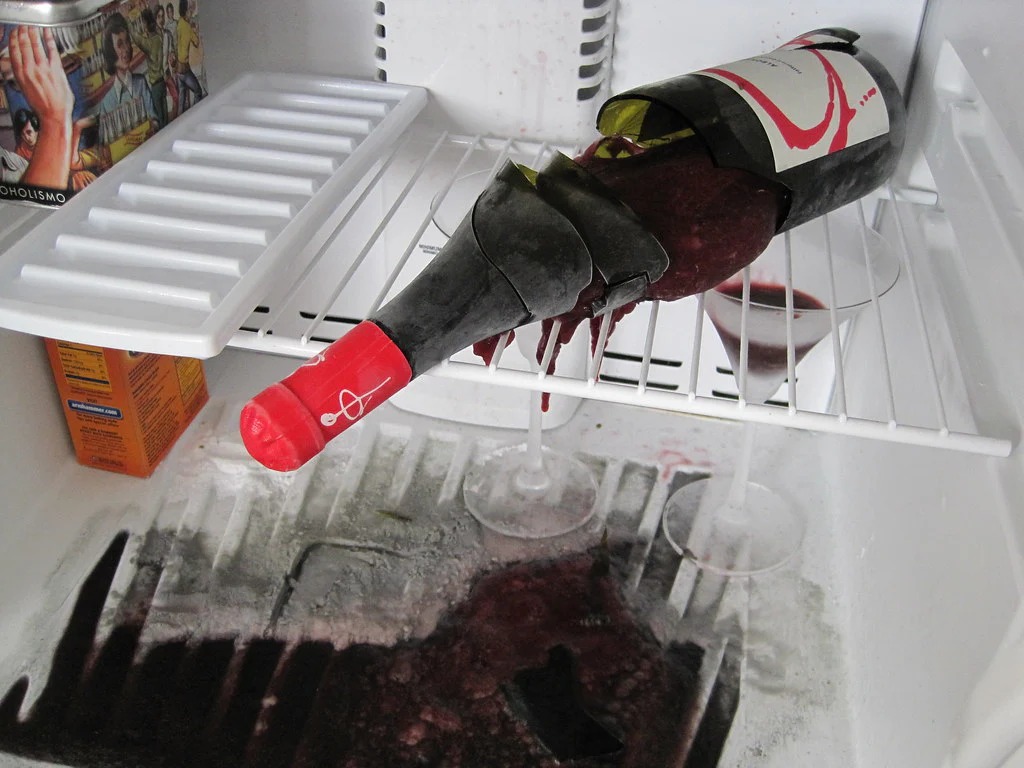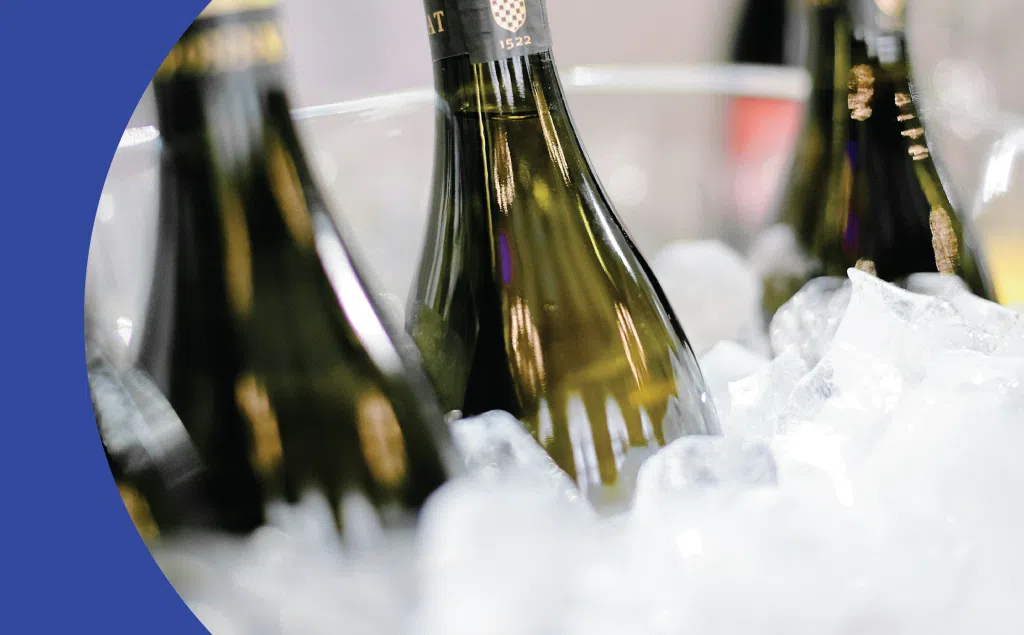
Ever shoved a glass bottle of water, soda, or juice into the freezer for a quick chill, only to return to a messy explosion of shards? You’re not alone. That dramatic shattering isn’t random bad luck – it’s physics in action. While glass feels solid and unchanging, the water inside undergoes a powerful transformation when frozen, creating immense forces the bottle simply can’t contain. Let’s break down exactly why your freezer becomes a danger zone for glass bottles.
Table of Contents
The Main Culprit: Water’s 9% Expansion
Placing a glass bottle in the freezer often leads to a messy disaster, and the core reason is surprisingly simple: water expands by about 9% when it freezes. Unlike most liquids that contract as they solidify, water’s unusual expansion creates immense pressure inside rigid containers. This unique property is the fundamental reason glass bottles surrender to the cold.
How Freezing Reshapes Water Molecules
As water cools below 4°C (39°F), its molecules begin arranging into a hexagonal crystal structure. This ice lattice contains more empty space than liquid water, forcing molecules farther apart. It’s this molecular rearrangement—not just the temperature drop—that drives the expansion.
Why 9% Packs a Devastating Punch
While a 9% volume increase sounds modest, its force is anything but. Freezing 10 cups of water yields nearly 11 cups of ice. Glass, being rigid and inflexible, cannot stretch to accommodate this change. The trapped ice pushes outward with incredible pressure—enough to fracture thick glass, split boulders through frost weathering, or even burst metal pipes. This same physics explains why forgotten soda cans explode in the freezer.
Glass: The Unforgiving Prison
Glass bottles fail catastrophically because they fight a battle they can’t win. Their walls resist expansion forcefully but lack elasticity. As ice crystals grow, pressure builds relentlessly against the unyielding container. When stress exceeds the glass’s structural limits, it shatters violently.
Nature’s Hidden Benefit
Water’s expansion has profound ecological value. Ice floats because it’s 9% less dense than liquid water. This creates an insulating layer atop frozen lakes and rivers, shielding aquatic life from extreme cold and maintaining habitats through winter—a silver lining to freezer mishaps.
The Unstoppable Force
Ultimately, freezing water is a quiet powerhouse. That 9% expansion, born from microscopic molecular shifts, generates forces capable of fragmenting glass, cracking stone, and sustaining life. It’s a vivid reminder that nature’s ordinary processes hold extraordinary power.
The Silent Stressor: Thermal Shock
Thermal shock is a stealthy culprit behind shattered glass bottles in freezers. It occurs when glass experiences sudden, extreme temperature changes. This rapid shift creates intense internal stress that rigid glass simply can’t absorb, leading to catastrophic failure.
How Thermal Shock Shatters Glass
When glass cools too quickly – like placing a room-temperature bottle directly into a freezer – its outer layer contracts faster than the inner core. This uneven shrinkage creates opposing forces within the material. Ordinary soda-lime glass (used in most bottles) is particularly vulnerable, fracturing under temperature differences as small as 60–80°C. Even borosilicate glass (found in quality bakeware), while resistant to shocks up to 165°C, can fail under extreme shifts or if microscopic flaws are present.
Real-World EvidenceResearch examining over 120 glass freezing scenarios reveals critical risk factors: bottles cooled rapidly, containers filled to capacity, and pre-existing damage like hairline cracks dramatically increase failure rates. This explains why freezing hot soup in Glass Jars often ends disastrously – the thermal differential simply overwhelms the material.
Defusing the Time Bomb
Thermal shock damage typically peaks within 4 hours as temperatures equalize inside the bottle. To avoid explosions:
- Always let liquids reach room temperature before freezing
- Thoroughly inspect bottles for chips, scratches, or imperfections
- Follow food safety guidelines for proper cooling procedures
Choosing the Right Glass
Material matters immensely:
Borosilicate glass withstands thermal shocks up to 165°C due to its low thermal expansion – but isn’t invincible
Regular soda-lime glass cracks under just 60–80°C shifts, making it prone to freezer disasters
The Unseen Danger
Thermal shock works invisibly but violently. What begins as an innocent act – chilling a drink quickly – can transform a glass bottle into a dangerous fragmentation hazard in mere hours as silent stress reaches its breaking point.
The Pressure Cooker Effect
Sealing liquid inside a glass bottle before freezing creates a miniature pressure cooker. As the liquid chills and begins freezing, it expands by approximately 9%. But glass refuses to stretch or flex, trapping the growing ice in an unyielding prison. This fundamental mismatch transforms innocent containers into potential shrapnel hazards.
Trapped Expansion’s Dangerous Math
Full bottles become worst-case scenarios. With zero empty space to absorb expansion, even initial ice formation generates catastrophic pressure. Thick glass walls offer false security – their rigidity becomes their downfall when confronting ice’s relentless push. Tightly sealed caps compound the danger by preventing any pressure release.
Design & Material: The Make-or-Break Factors
Bottle shape critically influences outcomes. Wide-mouth jars allow ice to expand upward like a frozen geyser, reducing sideways pressure on walls. Narrow-necked soda bottles, however, become pressure bombs – their constricted geometry concentrates force against vulnerable glass.
Material choice equally matters. Borosilicate glass (used in labware and premium bakeware) withstands pressure and thermal shifts better than standard soda-lime glass. Meanwhile, plastic or metal containers often dent but rarely explode, thanks to their ability to flex under stress – a life-saving feature glass inherently lacks.
Supercooling: The Ticking Time Bomb
Under precise conditions, water can remain liquid below freezing (-24°C/-11°F) when sealed in glass. Studies show bottles surviving over three hours in this supercooled state. But this delicate balance shatters instantly when ice crystals finally form. The delayed expansion then occurs violently, rupturing the container with explosive speed. This phenomenon makes glass particularly dangerous for slushy experiments.
The Unavoidable Conclusion
Glass bottles fail because physics gives them no choice. Ice’s 9% expansion generates forces exceeding 30,000 psi – enough to fracture concrete. Combine this with narrow shapes, full fills, or flawed glass, and disaster becomes inevitable. For safer freezing, leave 10-15% headspace in wide containers, or choose pressure-friendly alternatives like stainless steel or freezer-safe plastics. Your cleanup crew will thank you.

Why Glass Bottles Surrender to the Cold
Freezing glass bottles risks explosive consequences, but understanding the science transforms messy disasters into preventable mishaps. Multiple factors conspire against rigid containers in subzero temperatures – here’s what really happens behind that frosty door.
The Critical Buffer: Headspace
That empty air pocket at the bottle’s top isn’t wasted space – it’s a pressure-release savior. Liquid expands by 9% when frozen (500ml water becomes 545ml of ice). Without adequate headspace, the relentless push of crystallizing water has nowhere to go. The result? Glass walls endure stresses exceeding 30,000 psi – enough to fracture concrete, let alone brittle containers.
Material Matters: Glass Hierarchy
Not all glass suffers equally. Standard soda-lime glass (common in beverage bottles) turns treacherously brittle when chilled. Tempered varieties offer modest improvement but remain unreliable. True freezer warriors are borosilicate glasses – the lab-grade heroes with exceptional thermal shock resistance. Always check for “freezer-safe” labeling, and remember: microscopic flaws in any glass become catastrophic weak points under pressure.
Liquid Liability: Carbonation’s Double Threat
Carbonated drinks are freezer archenemies. While water’s 9% expansion poses enough danger, dissolved CO₂ gas escapes as temperature drops, creating a pressure multiplier effect. Beer or soda bottles essentially face two expanding forces working in tandem. Even “safe” liquids like broth become hazardous when containers lack headspace or suffer thermal shock.
The Freezing Process: Trapped Pockets & Thermal Shock
Rapid cooling creates invisible time bombs. When bottles chill too quickly, liquid can become trapped between frozen layers. These isolated pockets eventually freeze and expand with explosive force – a phenomenon confirmed in over 120 experimental trials. Sudden temperature drops (like placing hot soup jars directly in freezers) compound the danger by triggering thermal stress fractures, especially in standard glass vulnerable to just 60–80°C shifts.
Design Flaws: Shape Matters
Bottle geometry influences failure points. Narrow-necked designs trap expanding ice and bubbles, creating supercooling hazards that rupture without warning. Oddly angled containers develop stress concentrations at sharp curves. Meanwhile, wide-mouth jars allow upward ice expansion, significantly reducing sidewall pressure.
Practical Takeaways
Freezer survival boils down to physics: always leave 10-15% headspace, prioritize borosilicate glass, and avoid carbonated liquids. Never freeze hot containers – gradual cooling prevents trapped liquid pockets. Remember: that innocent glass bottle becomes a pressurized grenade when ice’s unstoppable expansion meets unyielding walls.
Your Shatter-Proof Freezer Strategy
Preventing glass explosions in the freezer combines smart material choices with simple physics hacks. These field-tested methods transform risky storage into reliable cold preservation.
The Headspace Lifeline
Always leave 2–3 inches of empty space at the jar’s top – the critical buffer zone where ice expansion happens safely. Real-world tests prove 1–2 inches frequently fails, allowing pressure to build against glass walls. This extra room lets freezing liquids expand upward rather than outward.
Glass Selection Secrets
Not all “freezer-safe” labels are equal. Trust specialized brands like Ball Mason, Weck, or Le Parfait whose thermal-shock-resistant borosilicate formulas handle ice expansion gracefully. Avoid jars with fused circles on the base – these stress points often crack under freezing pressure, especially with water-rich contents.
The Cooling Ritual
Never rush temperature transitions. Hot soups or liquids must first cool overnight in the refrigerator before entering subzero territory. Even robust canning jars surrender to thermal shock when facing sudden 150°F+ temperature drops.
Freezer Geography Matters
Cold zones are glass killers. Store bottles away from the freezer’s back wall and floor – its iciest regions causing violent temperature swings. Optimal spots are door shelves or top baskets where chill develops gradually.
Hydrophobic Advantage
When available, water-repellent coated glass changes freezing dynamics. By encouraging bottom-up crystallization, it prevents pressure buildup at the vulnerable rim area where standard glass often fails.
The Cardboard Shield
Nestling jars inside sturdy cardboard boxes creates a game-changing microclimate. This simple hack absorbs physical shocks from freezer vibrations while distributing cooling stress evenly across glass surfaces.
When Plastic Wins
For carbonated drinks or frequent freezing, flexible PET/PP plastic bottles are the undisputed champions. Commercial kitchens rely on their pressure-absorbing flexibility – a foolproof solution where glass would inevitably lose.
Conclusion
Glass bottles shatter in freezers due to an unforgiving combination: water’s 9% expansion, thermal shock stress, and rigid containment. While these forces can turn ordinary containers into icy shrapnel, the solution lies in engineered resilience. At TP Glass Bottle Manufacturer, we transform this fragility into strength. Our borosilicate glass bottles are precision-crafted with thermal-shock resistance and reinforced structural integrity, turning freezer risks into reliable cold storage.

